
Business • Marketplaces

Demand for online marketplaces is growing exponentially from both a consumer perspective as well as on the retailer front, with shoppers and merchants flocking to the likes of Amazon, eBay, Catch and Etsy to buy and sell their wares. So we thought it was about time to let you in on some of our trade secrets for selling on marketplaces, which we did so in our recent webinar: Marketplaces Masterclass: Your Strategy for Seller Success, hosted by Neto CEO, Ryan Murtagh.
Click below to watch the full webinar, or check out the show notes and useful links below.
Click below to jump to section.
First of all, for all of you that are very new to online retail, I'll define exactly what a marketplace is.
Ultimately, a marketplace is a central platform or website where third parties can sell goods direct to consumers.
Not too long ago, there were only one or two powerful marketplaces here in Australia (specifically, eBay_ but what we've seen in recent times is the introduction of many more to the market—Amazon, the Catch of the day marketplace and more—and I’ll go through the benefits of each in a moment, but first, what is the current state of marketplaces here in Australia?
There's been a lot of things going on in the world of marketplaces:
Australia Post recently released their annual Inside Australia Shopping Report which looks at consumer behaviour and trends based on analysis of goods bought online, and the standout finding from this report was that
marketplaces in Australia grew a whopping 74.8% year-on-year between last year and this year
which is incredible growth considering that eBay as a marketplace has been in this market for well over a decade.
It’s been a big eight months for Amazon Australia, they officially opened the doors to their Australian site in November last year, and even though many referred to it as a false start, it was actually the smoothest and quickest launch in all of their history, allowing them to test the waters, and test their technology in this market.
Like many of you would know, there was some recent GST law changes here in Australia, which has seen an even greater drive in traffic to the Amazon Australia site. Amazon US is now forcing Australian consumers to buy on the Amazon Australian marketplace, which is seeing a spike in Amazon Australia marketplace sales—at least that's what we're seeing throughout our customer base. And very recently they introduced Fulfilment by Amazon (FBA) in Australia, a service allowing you as a retailer to warehouse your products in Amazon's warehouses and they fulfil orders on your behalf. So this negates the need for you to have your own warehouse; you can leverage Amazon's warehouse space and therefore their technology and shipping providers, meaning you can focus more heavily on sourcing the right product at the right price.
While this is all going on with Amazon, we're also seeing a lot of changes happening with eBay.
They recently launched:
So Australia are really leading the charge in terms of innovation in online marketplaces and we’re seeing within our merchant base eBay sellers continuing to go from strength to strength, which is really exciting because eBay as a marketplace is one that partners with retailers rather than try to compete with them.
They've also—and you probably have seen them yourselves—really ramped up their advertising efforts here in Australia, so in mainstream media we’re seeing more and more advertising by eBay in competition to that of Amazon's.
| Related Reading: Amazon Prime vs eBay Plus
And we're also seeing a trend towards more cross-border trade, especially between Australia and Asia. Chinese e-commerce giant JD.com launched in Australia over the last year and Australian sellers are increasingly selling more and more products through the Alibaba Marketplace and Tmall, China's largest third party platform for brands and retailers.
Australia, in fact, is now ranked the third highest selling country into China.
So while there is still some uncertainty around marketplaces, we here at Neto wholeheartedly believe that marketplaces are very much the way of the future and the sentiment is shared amongst our merchants.
Last year we conducted a survey the day before Amazon launched in Australia to get a temperature check on the sentiment towards Amazon and other marketplaces, and of the few hundred Neto merchants who responded to that survey, 95% of them said that they actually intended to sell on Amazon in 2018, and that figure was just as high for eBay and other marketplaces.
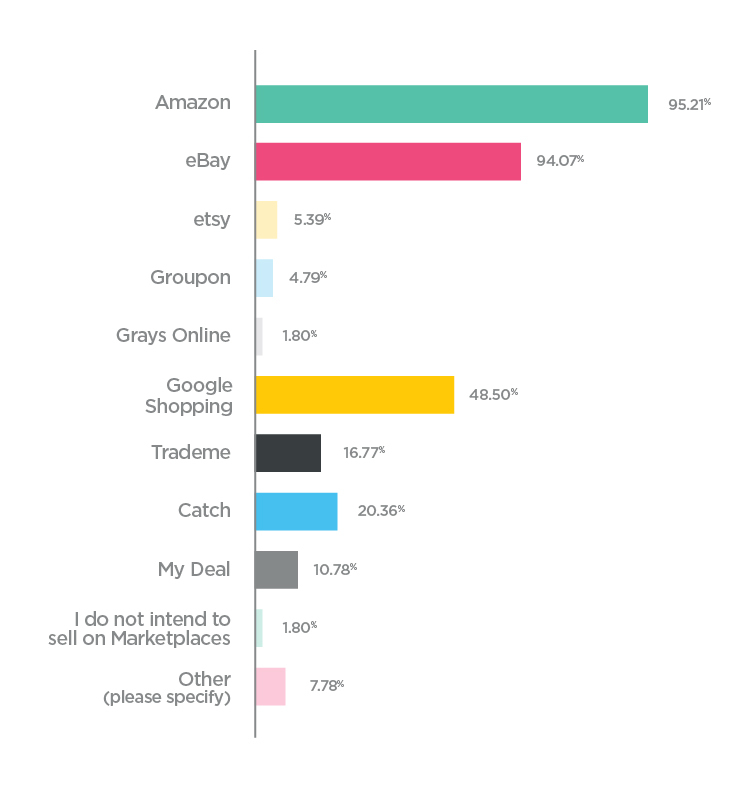
And on Neto, we're actually seeing that follow-through now; the number of our merchants that are adopting the Amazon Marketplace, the eBay marketplace and other marketplaces are now getting significant traction through them.
Some of our merchants are transacting more than 50 million dollars a year through marketplaces. So marketplaces are definitely a considerable sales channel for our customers.
There's a number of key reasons to sell on marketplaces:
The great thing about marketplaces is that you can leverage their reputation. You've already got a trusted brand and have household names selling through the marketplace platform, so for your own small business, for a very small fee, you can list your products alongside many of the biggest retailers in the country and compete directly with them. And like I said before we're seeing a significant amount of traffic going to these marketplaces, so you have the ability to take advantage of that traffic for a relatively low cost and a cost that you understand before you list.
You'll get access to:
Consumers tend to be more loyal to one platform, particularly with subscription services like Amazon Prime and eBay Plus, which will keep them coming back and it means they're also starting their product searches on platforms they are loyal to.
The likes of Amazon and eBay are spending a tremendous amount of money at the moment to acquire customers and build a loyal customer base. You as a merchant get the advantage of for a relatively low outlay, and a cost that is easily understandable allowing you to price your products appropriately.
I think that it is really important to know that marketplaces are really technology companies. Amazon is a technology and data company and so is eBay, and for small businesses to compete with that technology in evolving and new sales channels like voice commerce, it's becoming increasingly difficult. So it's important that you as a retailer are surfacing your inventory in these new sales channels.
For example, Amazon Alexa can be seen as a sales channel: voice commerce. For you to have your products available through Amazon Alexa in theory, you have to have those products listed on the Amazon Marketplace and it's incredibly important nowadays that your products are readily available wherever consumers are. In the future, no doubt there'll be more sales channels that consumers will be purchasing through and it's vital that you as a retailer are able to surface your inventory through these channels, and by being on marketplaces you get the advantage of being able to do that again at a relatively low cost.
It's important that you know that shoppers really do prefer marketplaces. We surveyed 1,001 active online shoppers here in Australia just before Amazon launched and we found that marketplaces are shoppers first preference for buying online in this country, in front of company websites and social media.
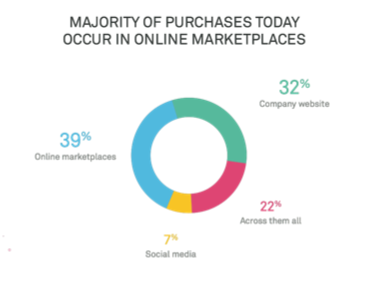
We developed a report recently where we compared 16 of the top marketplaces in Australia and globally on the basis of reach, cost and a number of other metrics, including Amazon, eBay, Alibaba, Tmall, Etsy, TradeMe the list goes on, but for the sake of time I’m just going to run through a few. Read the full report.
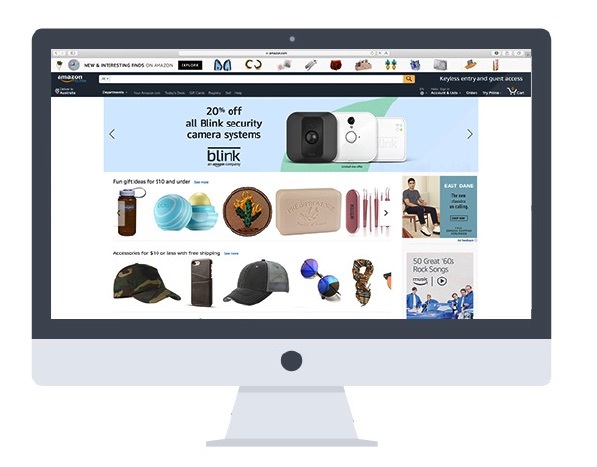
This is because there are some differences between each marketplace including the category tree and the available product categories to sell through etc. That's an important difference between Amazon and eBay, where with eBay you actually create a single account and you can list to multiple different eBay marketplaces.
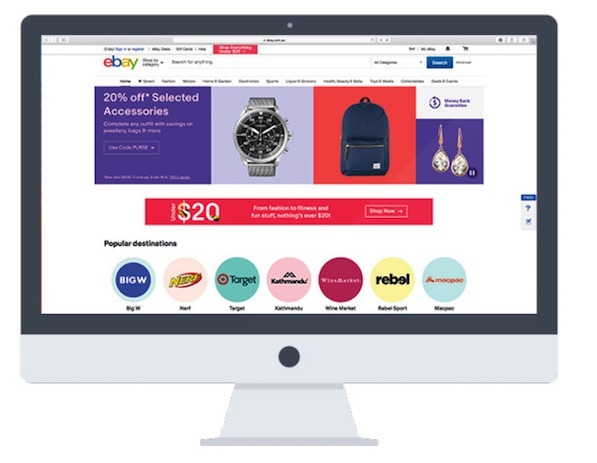
A lot of people still perceive marketplaces, and specifically eBay, as being a place to buy second-hand goods, but it's very much changed in recent times—90% of the items are brand new and delivered by reputable retailers—they sort of offloaded that secondhand goods market to the likes of Gumtree (also owned by eBay).
Probably bigger than any difference between Amazon and eBay, is that eBay is really about partnering with retailers to grow them both on and off eBay, and grow their brand by leveraging the eBay platform. With eBay you've got a lot more control over your brand and your product listings than you might have with say Amazon, who ultimately is a hybrid of a marketplace and an online retailer, because they also purchase inventory and sell direct to consumers as well as acting as a marketplace where third-party sellers can list their inventory. Their goal is to offer earth’s largest selection of products.
eBay is still Australia’s favourite marketplace, which we're seeing through the Neto platform with a significantly greater number of transactions going through the eBay marketplace than Amazon for us at the moment, and also with almost triple the monthly website visits of Amazon Australia. But we are seeing Amazon steadily growing, and therefore it's really important that you as a retailer get in early and take advantage of first mover advantages on Amazon because there are big benefits (which we'll talk about a little later).

The next marketplace and that we believe you should be focusing on at the moment is the Catch marketplace.
Originally Catch of the Day and Australia's largest daily deals site, they would offer a small range of products at ridiculous prices, which then evolved into a large online department store with a huge distribution facility complete with robotics down in Melbourne. Now Catch has evolved into a hybrid marketplace/online retail operation, much like Amazon.
They have their own loyalty program, Catch Club, and they're seeing more and more retailers sell through the platform. We also have some Neto retailers selling through Catch that are doing exceptionally well, so if you haven't looked at Catch as a marketplace opportunity for your business, it's definitely one to consider!
The answer is: go where the customers are. A recent Roy Morgan report found that nearly 14 million Australians aged 14+ visit online marketplace sites in an average four week period. And of those marketplaces, eBay is by far the leading marketplace, with almost triple the visits of Amazon. But with all of Amazon’s momentum and advertising, they are likely to catch up quickly and historically we've seen in other countries that they've entered into—Canada and others—it does take them a little bit a while to get traction, and set up their distribution network.
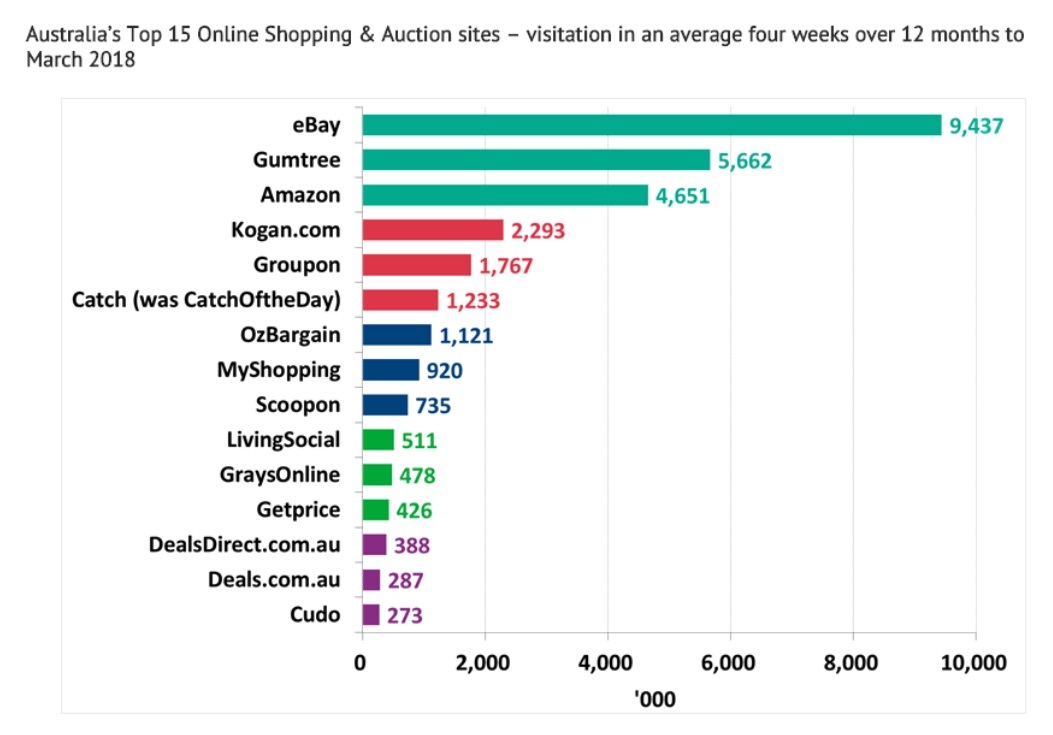
Now we will move into the second part of the webinar - we’ve covered why marketplaces and which marketplaces are out there, now for how to actually succeed on marketplaces...
First of all, it's really important to choose the right products to sell through the various marketplaces—some products might not be suited for certain marketplaces, or they might not even be accepted by those marketplaces. As an example, Amazon haven't yet opened up all of the available categories that they have in other countries here in Australia.
Businesses that have unique products, that import and distribute products with their own brand, or have a very niche offering do exceptionally well on marketplaces, so it's really important to research and find a niche that sets you apart from your competition.
Marketplaces are a really great testing ground for new products and ideas, and a great way to research and test what sells, because at the end of the day you typically only pay a marketplace fee on the sale of an item and maybe a monthly subscription fee, so there's very little risk or cost involved.
Check out competitors' listings for products similar to your own. Which seem to be performing well and which don’t? Doing research will also help you decide on the categories that best suit your product, how to write a great listing (and what doesn’t resonate) and whether a fixed price or auction listing is the way to go.
There are great tools out there that you can use for product research and to find niches in the market. One of our favourites is Terapeak, a tool that allows you to research what other sellers are selling on marketplaces and through artificial intelligence it can even recommend opportunities for you and your products on the likes of eBay. This is also a great way to understand how much you should be charging for your products in relation to competitors, and the volume that you can expect to sell before investing in purchasing or importing inventory.
This is relevant for most marketplace platforms as your product title is heavily weighted in a marketplace search algorithm. Amazon has really strict guidelines on formatting the title of your product depending on the category that you sell on, but the general format you can follow for Amazon (and it's probably a good format to follow for other marketplaces too) is:

Use all of the space available in the title!
Number three is to really use and take advantage of the bullet points fields on Amazon and then the attributes fields.
For Amazon, here’s the format they suggest for what to include in each of the 5 bullet points:
So in this example below of the bullet points for a hair dryer, the bullet describe both the key technical specifications of the hairdryer (the construction) in the wattage, heat and speed settings, and attachments, as well as the benefits of these features; e.g. the ceramic coated grill produces infrared heat 'fast-drying hair from the inside out'.

What you include in your bullets is not only important in terms of a consumer finding the information they need to make a purchase decision quickly, it's also really important in terms of your search rankings—bullet points are reported to be weighted heavily in Amazon's search ranking.
Another example of this is that if someone is searching for a product and then wants to refine their search using filters like colour or size, and you've included these specifics in your bullets and description, your products will actually appear for those filters. So a faceted search model is really important when building out your database of products. Ensure that in whichever ecommerce platform you use, you've got those specifics defined in text fields that will pass through to the marketplace, rather than just being populated into your product description and amongst all your other texts. By having those specifics individually listed out you will be able to feed them through to your marketplace as a choice and improve your your search rankings and conversion rate.
This refers to the formatting of the description part of your listing - which is where you get the opportunity to communicate the USP of your product and sell!
What we see from a lot of immature sellers or people just starting out on marketplaces is that they like to stuff the description with bright colours and interesting fonts; however when you're selling on a marketplace like Amazon, they only accept a text description, so you have to then go and re-do your description for that marketplace.
To ensure that your description can be leveraged across all of your sales channels keep it as simple as possible, in plain text and use bullet points to effectively communicate key information, quickly. Remember that shoppers tend to scan and you only get a second or two to impress before they hit the back button. It's the content of your description that matters not how it looks and feels.
Keywords are just as important on marketplaces as they are on Google, especially for Amazon.

If customers can get a really good view of your product it does lead to much better conversion rates, so don't invest too much time in editing your own product images, instead use a service like Pixc, and focus your energy on growing your business.
Depending on which marketplace you sell on you might have the opportunity to include your branding to make your products or store stand out.
Specifically, eBay is all about partnering with retailers and enabling them to grow their business and brand through the marketplace. eBay Feature Stores are your own shopfront where you can create a visual, vibrant and true representation of your business, and you can lay out your inventory in a way that suits you. There's different versions of eBay store subscriptions that give you different levels of flexibility and control, but ultimately with eBay you do have the opportunity to brand your store to look exactly like your own website and offline branding.
In this example, Neto customer Lucky Pet have customised their eBay Feature Store to look very much like their own website, so that the experience that the customer has, be it the Lucky Pet website, in-store on eBay, is very much the same.
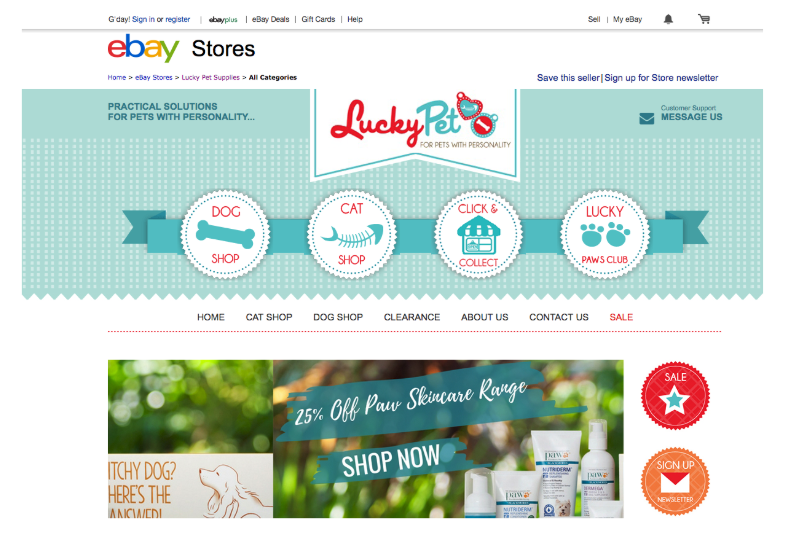
A little bit on pricing and pricing your products for marketplaces. There are tonnes of different pricing strategies out there but I’m going to share a couple of key things to be aware of and one hack that will have you miles ahead of the rest on marketplaces.
3. Competitive pricing
Now it’s time to see what your competition is up to. Who are they, where do they sit on the first page of an Amazon search, and what are their prices? This is a time consuming task, but it’s a must-do and should be done often. Luckily it can be automated which I’ll go through in a minute. And like I mentioned Terapeak is a really good tool if you're looking to do competitive pricing where you're going to price your products based on a lower and upper limit and what your competitors are charging.
We see a lot of business owners make the mistake of charging a different price through each different sales channels. On their website, they will charge one price and on a marketplace, they'll charge another price and what this leads to is maybe a short term win, but in the long term a really poor customer experience. Nowadays the cost of acquiring a customer is so high, it's critically important that you provide a consistent customer experience across all your sales channels and platforms, and Neto can enable you to do that very simply and easily! Last year we did a survey and we found that 75% of customers expect pricing to be the same across all sales channels.
6. Dynamic Repricing Tools
I mentioned a tool just before for dynamic repricing or for automating your pricing, so that you don't have to manually be updating your pricing when competitors change their pricing and one in particular that we recommend is called StreetPricer.
Streetpricer looks at the pricing of your products against your competitors on the various marketplaces and you can then set a minimum and maximum price that you want to charge for your product, or a threshold based on your cost price, and it will automatically reprice your products based on what competitors are charging for that same product on the various marketplaces, allowing you to completely automate your pricing strategy.
So these tools are really great, especially if you have a very large range of products and if you're selling products that are highly competitive in the market.
These are all things that ultimately lead to a great customer experience and service and as such, will lead to higher ratings from customers.
Amazon
It’s also important that you don't go out and proactively ask your customers for reviews; especially if they're Amazon customers. It is actually against Amazon's policy. Even slipping a piece of paper in your package is non-compliance.
The more reviews your listing receives, the more easily Amazon will categorise your listing. This is because reviewers tend to include relevant keywords naturally in text. The Amazon search function prioritises listings with more reviews—positive or negative (and it can tell the difference).
eBay
On eBay it's much the same: your eBay seller rating is up there for everyone to see and it can drastically impact on your conversion rates and also on your ranking within the eBay search engine. To be a Top Rated Seller you’ll need a score of 100 or more with at least a 98% positive feedback rate.
Another reason why getting awesome seller reviews is important, for Amazon specifically, is it can help you to win the Amazon Buy Box.
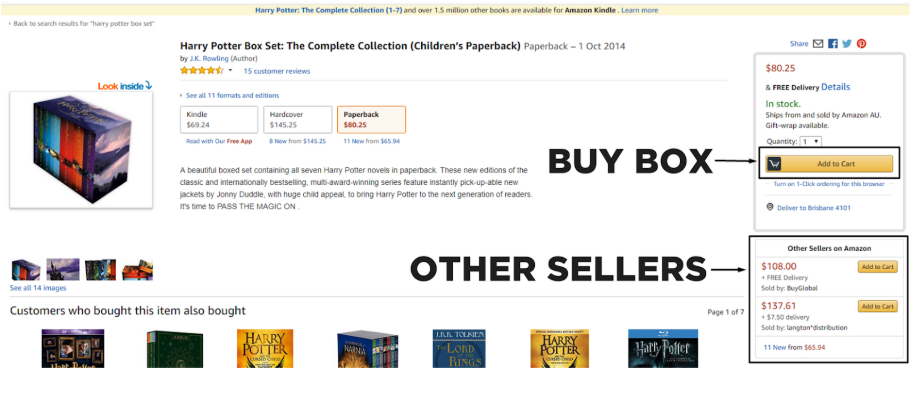
The Buy Box is something that we we get asked about a lot. One of the biggest differences between Amazon and other marketplaces is that, unlike eBay, where every product has individual listings for each seller, on Amazon, a product that has got multiple sellers will only have one listing and one ‘buy button'.
Winning the Buy Box is critically important for sellers because it's only occupied by one seller at any point in time, and if you don't occupy that buy button on Amazon at all, your chance of converting sales is significantly lower: if there's five sellers for a single product, only one seller will be assigned to the Buy Box and 82% of all sales on Amazon come through the buy box, so the other 18 businesses are clicking on the 'other sellers on Amazon' below the buy box, but more than likely they're clicking on the 'Add to Cart' button.
So how do you win the Buy Box?
Well, the algorithm is obviously not public knowledge given that it's so important, but there are a couple of tips that are relevant, and pretty much everything that we've been speaking about today is relevant.
Our belief is that success really does come down to having a unified commerce platform. A platform that enables you to sell everywhere and manage all of your back-office from a single integrated solution, that ultimately enables you to deliver the best possible customer experience. And we believe that there's four key pillars to a unified commerce solution:
Unified Commerce Pillars
These are the things that we at Neto are focused on delivering as a platform in a single unified solution.
What does Neto do? With Neto being a unified commerce solution, you can sell everywhere from a single integrated solution:
But what really makes us different is the fact you can manage your back-office operations from one central solution that delivers a seamless customer experience:
Q. Could you please provide some more info on the Wholesale B2B option?
A. We're seeing a real trend towards wholesalers or traditional business-to-business operations creating retail operations and selling through marketplaces either under a different brand, which you can do with Neto. So you can have a webstore in one brand and your marketplace can be under a different brand.
We do have a bunch of wholesale features built into our platform.
But a list of all wholesale related features is available on our website otherwise always just pick up the phone and give our sales team a call and they can walk you through the specific functions for your business.
| Related Reading: Double Your Sales and Expand Your Reach With B2B Wholesaling
Q. You mentioned how important SEO is for product pages, what about for your homepage?
A. Yes, your home page is one of the most important pages on your website so yes, it's really important to identify the keywords that best describe your business and that are going to drive traffic to your business. And then ensuring that those keywords are entwined in your home page—that they are leveraged in your home page meta title and description and that you're pointing relevant traffic related to those keywords to your home page as well. So SEO is really important obviously for your own website, not just for your product listings on marketplaces.
Q. Would there be an optimal number of product types or SKUs to list to a marketplace?
A. SKU is a stock keeping unit for an individual product.
There isn't really an optimal number of SKUs. I would say list everything that you have. But this will depend of course on the particular seller pricing plan you're on. Typically, if you're on the right plan, it's not going to cost you anything to list your products, and so I would say take advantage of that and list everything you're spreading a much wider net for someone to find your inventory especially on Amazon where you pay a set fee per month and unlimited listings. This can be different with eBay, but I would say put everything on and refine from there. Nut ultimately it's a much better chance of being found on the marketplace and people will find one this thing and then drill into your store to find the rest of them. In terms of the customer journey, the more spokes you have in the wheel the better chance of someone finding you.
A. There's a bit of consumer psychology involved in this. What we find most of our retailers do is they only list a small percentage of their inventory to marketplaces. Given the fact that our system can automatically maintain stock levels this gives the perception that you may be running low on stock and create urgency from a buyer's perspective. So, for example if you've got 1000 of a particular SKU in stock, you might want to only send 5 up to a particular marketplace. Then 5 will show as available creating a sense of urgency from a consumer side, rather than if you had 1000 showing. On the flip side of that you might have some of this wanting to buy a thousand of your product and won't be able to do so if you don't list your full inventory. So I think this is dependent on the types of products that you are selling. But we do see a lot of our reads, especially those that sell high value items only pass through a small quantity of what they actually have available to sell to improve their sales conversion rates.
With Neto you can then print your shipping labels and Neto will manifest it with the carrier and send the tracking number back to the marketplace to notify them that you've shipped the product. There's no need to use third-party shipping software when using the Neto platform.
Q. Do you support shopping carts?
A. We will soon support a number of other shopping cart solutions—if you're already using another shopping cart and you don't want to get rid of your existing website. So for example, you might be using Shopify, which is a simple solution for small online stores. You could keep that website front-end and you can integrate it into Neto which can do all of your back-end order management, inventory, shipping and marketplace management. There's no need to switch if you've already invested into your front end (and you're happy with it), you can continue to use your own shopping cart. We believe that being agnostic to the sales channel is what's important.
Q. If I run a promotion on my webstore will that promotion price be syndicated across all my sales channels?
A. With Neto the answer is yes. You can select to have whatever your available store price is to be your price across all marketplaces and then when the product goes on promotion in your webstore that promotion price will flow through to your chosen marketplace. You can also choose to have marketplace specific pricing and map your price levels in Neto to your different marketplaces. Like I said earlier in this presentation though, it really isn't a good customer experience to find your product at different price points across the internet or even offline so we wouldn't suggest doing this unless you're using a different brand on a particular marketplace (which is something you can do with our platform).
Q. Will the invoice come from the marketplace or from my business?
A. It's dependent on the marketplace.
eBay: Neto will automatically send out an invoice to the customer with your branding and messaging, as with eBay the customer is paying you. So you define the payment options, they pay your PayPal account or by direct deposit specifically and you'll invoice the customer.
Amazon and Catch: the customer will receive an invoice from those entities themselves with the reason being that the customer is actually paying Amazon and Catch directly. So the invoices will be branded as such.
It's really important again to note that a big difference between eBay and Amazon is that Amazon owns the customer, and they're very strict about your communications with the customer. You cannot email that customer directly on Amazon, you cannot communicate directly with a customer whether it's a flyer in the package with the goods or an email. They don't actually provide you with the customer's email address, instead you get an encoded email address that routes the email back to the customer. So don't try trick them because they've got lots of smarts around that and will promptly ban your account.
We hope these insights and key takeaways have been helpful for planning out your online marketplaces strategy!
If you want to watch the webinar in full, you can watch it here and if you have any questions or would like to chat to our team about how we can help your business get on marketplaces, get in contact.